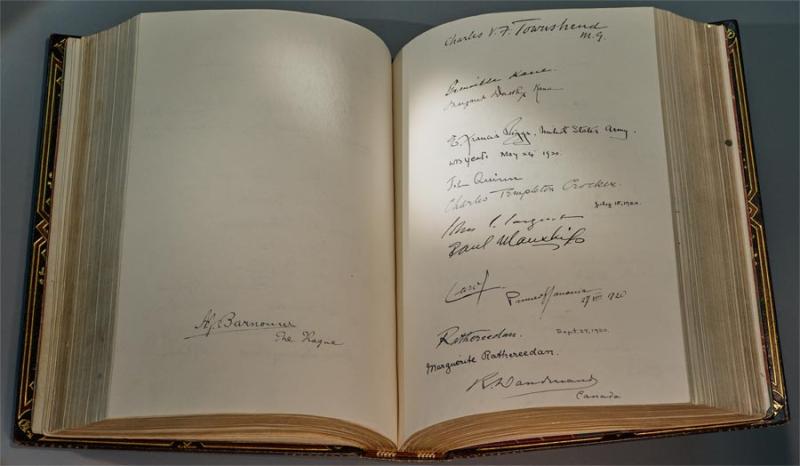 I always had a strong suspicion that one of my favorite poets, William Butler Yeats, must have visited Pierpont Morgan’s library during one of his four visits to New York City between 1911 and 1933. When Yeats first came to New York, in November 1903, construction had only just begun on the intimate palazzo-like structure designed by Charles Follen McKim. Recently, when looking through the old visitors’ book, an ornately bound volume titled J. P. Morgan et Amicorum (“J. P. Morgan and Friends”), I made a discovery that confirmed my hunch.
I always had a strong suspicion that one of my favorite poets, William Butler Yeats, must have visited Pierpont Morgan’s library during one of his four visits to New York City between 1911 and 1933. When Yeats first came to New York, in November 1903, construction had only just begun on the intimate palazzo-like structure designed by Charles Follen McKim. Recently, when looking through the old visitors’ book, an ornately bound volume titled J. P. Morgan et Amicorum (“J. P. Morgan and Friends”), I made a discovery that confirmed my hunch.
In the course of research for an essay—to appear in a book being published next summer in conjunction with our exhibition Henry James and American Painting—I was trying to ascertain the date in 1911 when the famous American novelist visited the library. Once I had found it (he came here on January 18, 1911) my curiosity kept me browsing. Turning the pages, I looked specifically at dates when I knew that Yeats was in and out of the city: October 1911, February to April 1914, and January to May 1920. Surely, I said to myself, Yeats would have visited the greatest private library in New York on at least one of his trips?
The official chronology of W. B. Yeats’s life is silent concerning his activities on May 24, 1920. We know that after an extensive lecture tour of the United States and Canada he returned to New York on May 10. Yeats and his wife stayed at the apartment of their friend, the lawyer and art collector John Quinn, during the final weeks of their trip. He and Quinn met with Éamon de Valera on the evening of May 17. Yeats found the future president of the Republic of Ireland disappointing, “a living argument rather than a living man, all propaganda, no human life, but not bitter or hysterical or unjust.” The next day, he told his friend Lady Gregory, he was “to have a record taken of myself for a new kind of moving picture—a picture that talks as well as moves.” (This film has never been traced.) In his spare hours Yeats engaged in automatic writing sessions with his wife and dined regularly with his father who, since moving from Dublin to New York in 1907 to revitalize his languishing artistic career, had been the beneficiary of Quinn’s patronage. As I scanned the assorted signatures, stacked one upon another on each page, Yeats’s name—written with such uncharacteristic neatness and legibility as to suggest that he felt a strong sense of occasion—suddenly leapt out. And, of course, he came here with his host, John Quinn, whose name appears immediately below the poet’s. On May 24, 1920, Yeats and Quinn would have been met by Belle da Costa Greene, hired by Pierpont Morgan in 1905 to be his librarian. There is no other documentary record of Yeats’s visit; he never mentioned it in his correspondence. This discovery raises lots of other unanswerable questions: how long was his visit to the library? what manuscripts and books did he see when he was here? what did they talk about? We may never know. But it’s enough, for me, to know that he was here.


